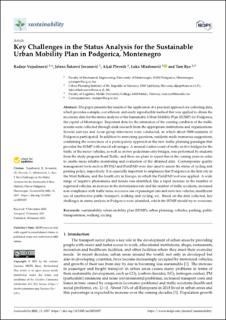| dc.description.abstract | The paper presents the results of the application of a practical approach for collecting data, which provides a simple, cost efficient, and easily reproducible method that was applied to obtain the necessary data for the status analysis of the Sustainable Urban Mobility Plan (SUMP) for Podgorica, the capital of Montenegro. Important data for the estimation of the existing condition of the traffic system were collected through desk research from the appropriate institutions and organizations. Several surveys and focus group interviews were conducted, in which about 5000 residents of Podgorica participated. In addition to answering questions, residents made numerous suggestions, confirming the correctness of a participatory approach in the new traffic planning paradigm that provides the SUMP with crucial advantages. A manual cordon count of traffic on five bridges for the traffic of the motor vehicles, as well as on two pedestrian-only bridges, was performed by students from the study program Road Traffic, and there are plans to repeat this in the coming years in order to enable more reliable monitoring and evaluation of the obtained data. Contemporary quality management tools such as BYPAD and ParkPAD were also used to assess the status of cycling and parking policy, respectively. It is especially important to emphasize that Podgorica is the first city in the West Balkans, and the fourth city in Europe, in which the ParkPAD tool was applied. A wide range of negative phenomena and trends was identified, like a rapid increase in the number of registered vehicles, an increase in the motorization rate and the number of traffic accidents, increased non-compliance with traffic rules, excessive use of passenger cars and auto-taxi vehicles, insufficient use of unattractive public transport, walking and cycling, etc. Based on the data collected, key challenges in status analysis in Podgorica were identified, which the SUMP should try to overcome. View Full-Text Keywords: sustainability urban mobility plan (SUMP), urban planning, vehicles, parking, public transportation, walking, cycling | en_US |

